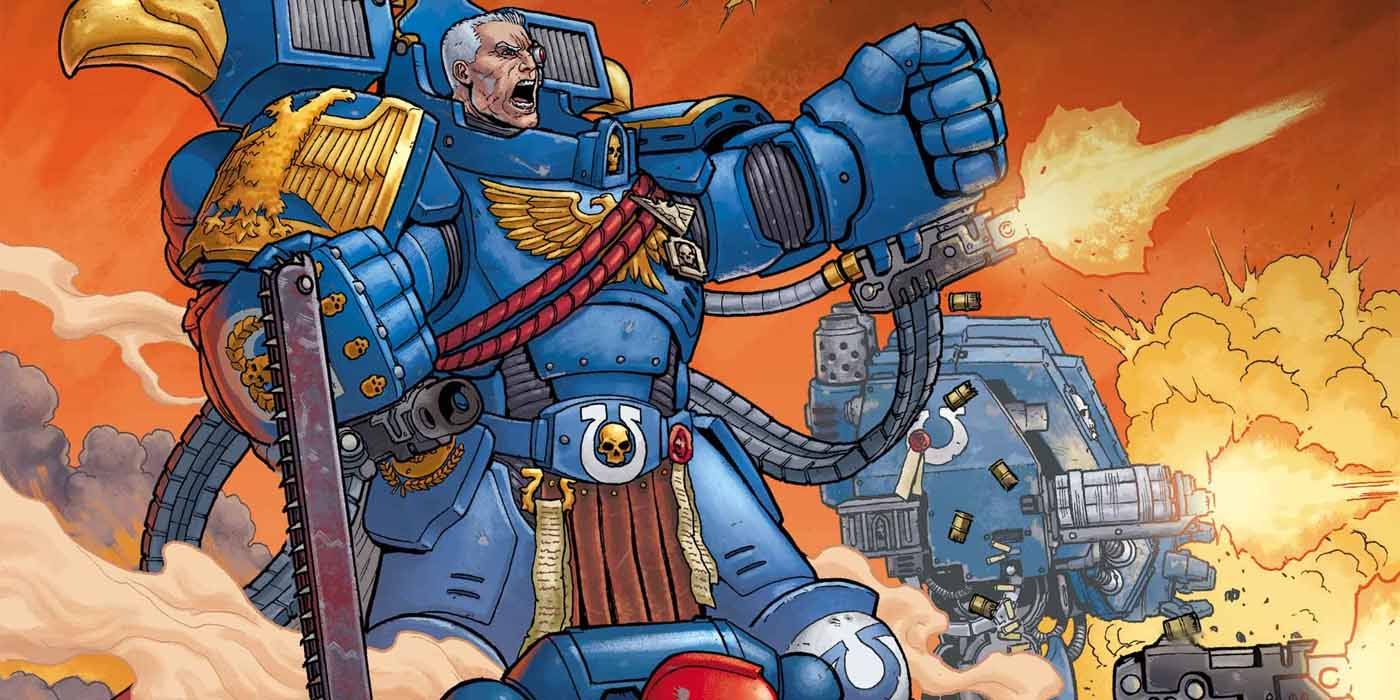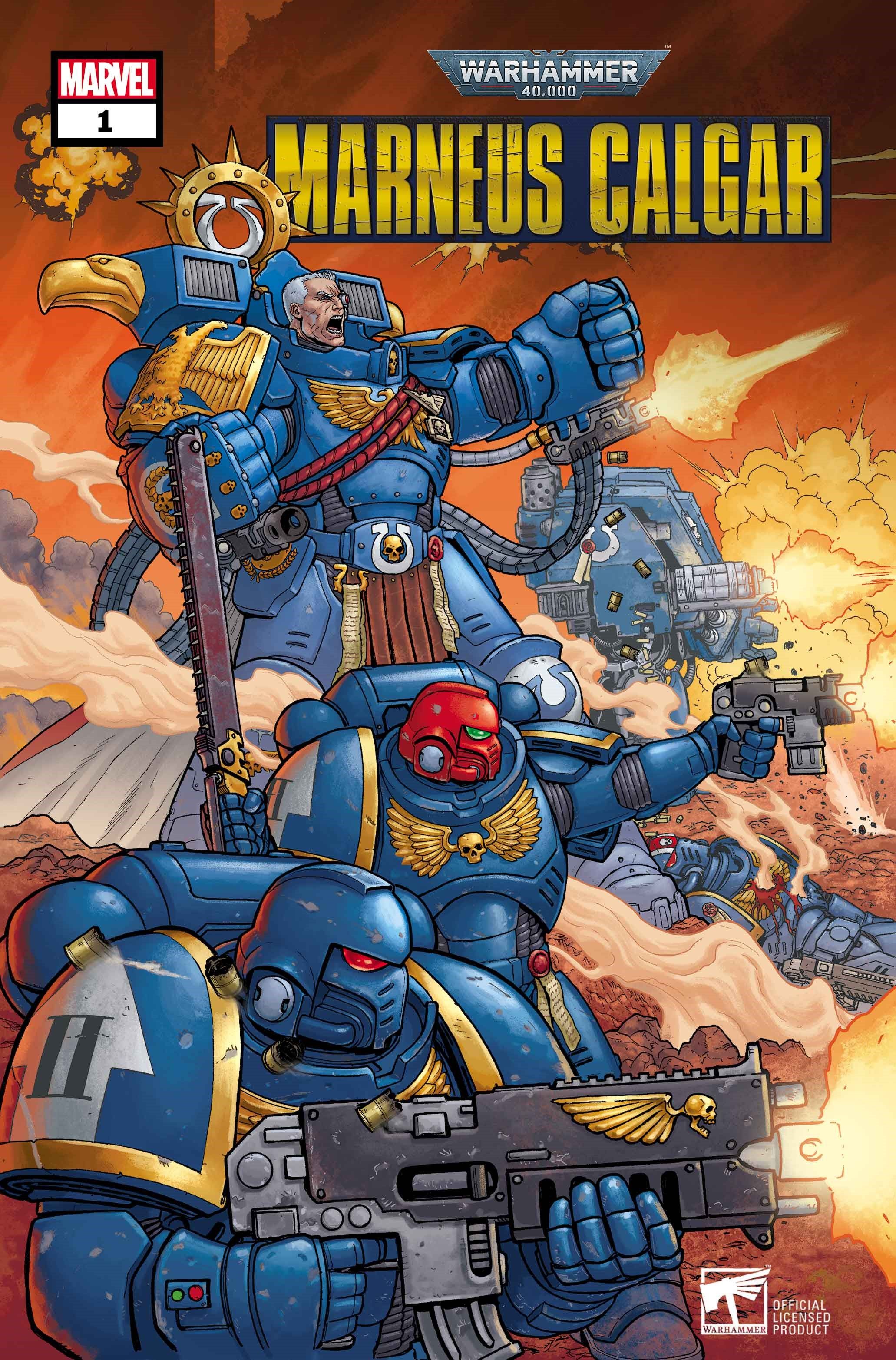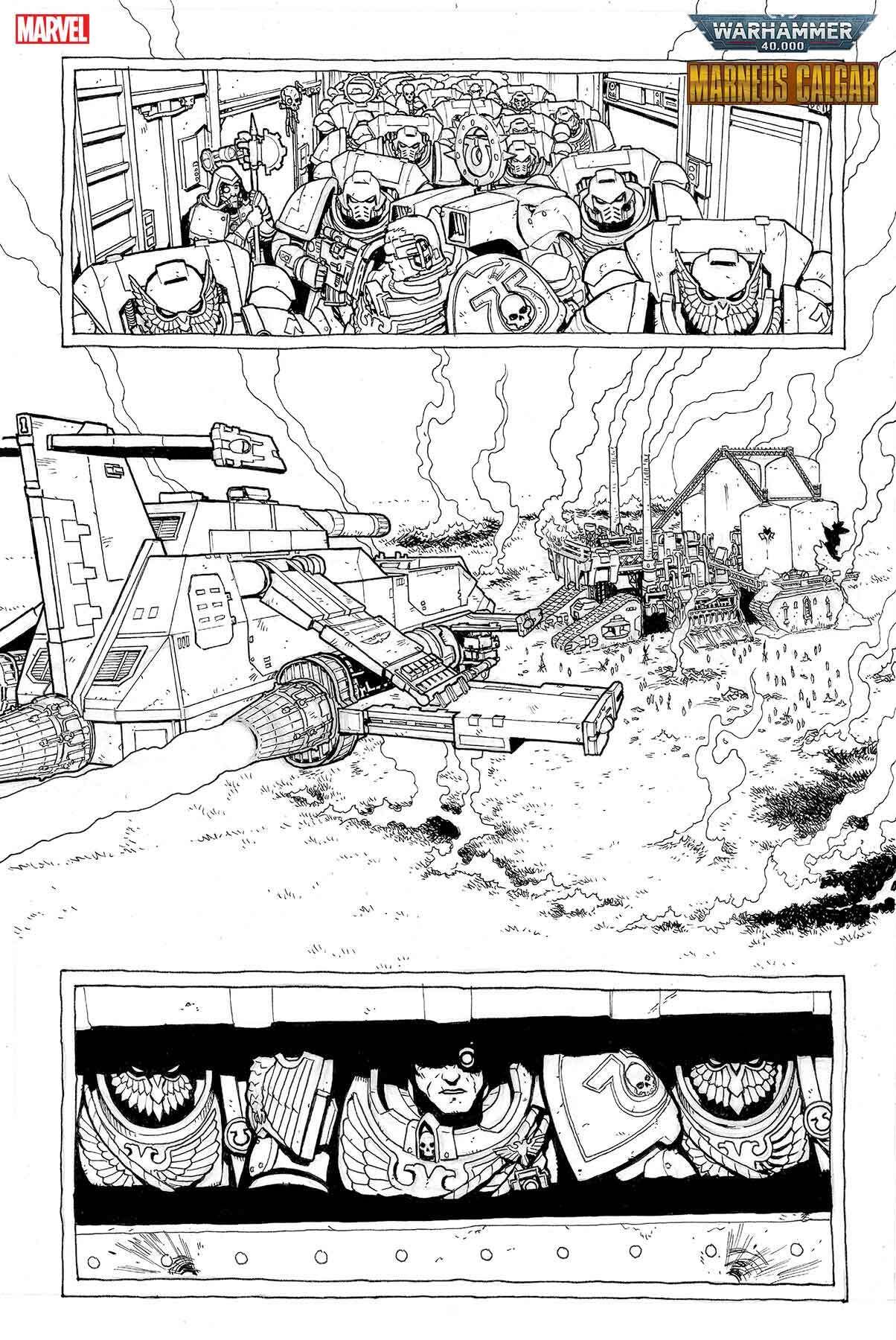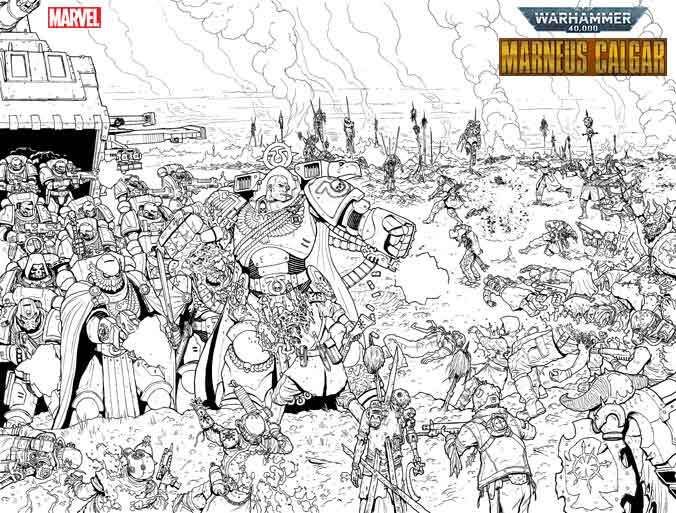In 1987, Games Workshop introduced the world to the hobby universe of the Warhammer 40,000 (40K for short) miniatures game. It's a dark, dystopian hellscape of military science fiction, supernatural horror, and fantasy, where heroes are caught up in horrific systems and tyrants are empowered by them. It's also a place where humanity uses genetically engineered, power armor clad super-soldiers known as Space Marines to prop up a crumbling empire that's been targeted by hostile “Xenos” armies and the supernaturally corrupted forces of the Chaos gods.
The most famous Space Marine Legion is a chapter called the Ultramarines, who are known for their tactical acumen. Their demigod-like Primarch/founder, Roboute Guilliman, was famously resurrected through the super-science of the tech-worshipping religious cult known as the Adeptus Mechanicus. And soon, comics readers will get a chance to learn more about the Mechanicus, Guilliman, the Ultramarines, and their most distinguished member, Chapter Master Marneus Calgar.
Warhammer super-fan and acclaimed writer Kieron Gillen and artist Jacen Burrows kick off Marvel's Warhammer 40,000 line with the release of Marneus Calgar #1. CBR spoke with Gillen about the book, his plans to make it both accessible to new readers and pleasing for long time fans, and his history with the Warhammer hobby.
CBR: You've returned to Marvel to help kick off the Warhammer 40,000 line. How does that compare to writing other big-name properties James Bond and Star Wars?
Kieron Gillen: [Laughs] It's different. In real amount of hours spent engaging the activity, this probably means it's more personal than most of them -- or at least, more uniquely personal. Bond is like a cultural icon. It's a bit like getting to write something that's always been there as part of life. And the first movie I saw at the cinemas was Empire Strikes Back. So to write my own prologue to my entry into geek culture was a great thing, but Star Wars is also mainstream culture. Your parents could tell you about Jedi Knights, but they likely wouldn't be able to tell you about the Primarchs.
Warhammer is different, in that it's something that I came to at a certain point in my life, and has been something that's followed through all the years afterwards, even directly or indirectly. I've been into the hobby more years than I've been out it. I got into Games Workshop pretty much as puberty hit. [Laughs] The specifics of this world, how it hit me, and the delight I took from it is something I remember quite strongly. It felt like finding the hard stuff. I still paint Warhammer miniatures, play games, and introduce interested friends to the hobby.
Games Workshop comes from the Midlands of England. That's basically where Heavy Metal came from, and the teenage metalhead in me absolutely loves Warhammer.
[Laughs] Same. I've always described 4oK as Lovecraftian horror meets Stars Wars meets Doom, with a hint of Lord of the Rings, a noirish moral sensibility, and a heavy metal visual aesthetic.
Exactly. It's very maximalist. People often say, “Less is more.”Warhammer argues the opposite. It says, “More is more.” That's really what "more" means. [Laughs]
For people coming to this interview with no real knowledge of 40K, how would you describe the world? What are some of the aspects you find most fascinating?
40K is a far future hellscape. That doesn't quite capture the scope though. It's a hobby universe where there's a theocratic regime with a God-Emperor that's fed thousands of souls of psychic human beings every day in order to stay alive and act as a glorified lighthouse. That awful scale is what makes it palatable. [Laughs.] This isn't like the small scale horror we see every day. This is operatic in its awfulness. That's the emotional kick.
I could write essays about the world of Warhammer, but it all circles around those “grimdark” concepts and whatever that even means. That's a word that's entered geek discourse, and, of course, it originates from the incredible 40K tagline, “In the grim darkness of the far future there is only war...” Talk about copywriting! That's a hell of a sentence. It's like, “OH! Tell me more about this future!”
So, it's a horror universe, but it's also a satirical and action universe. The people who take Warhammer a bit too straight clearly are working on the weird assumption they would be Space Marines when it's clear that if any of us were in the 40K universe we would be someone who was bombarded from orbit to clear out a rabid infection running through the tiny human population. It's so operatically, grim.
What's it like writing Marvel's first 40K book knowing you have an audience of both established fans and potential new ones?
In 2003, I sold my first ever comics script to Games Workshop when they were publishing their own Warhammer Monthly. One of my two strips for them involved Necrons [An alien empire composed of metallic skeletal warriors.] And in 2008, when Boom! had the license for Warhammer fantasy comics, I wrote a mini called Crown of Destruction. That was my first American work-for-hire comic. That's also where I learned to write action comics. That's where I got to try out a lot of stuff I later used at Marvel. It's where I learned things like how to use a splash page. So, Warhammer has been part of my development even on a professional level.
Now, I'm coming back to it as an established writer. It's weird to even think that. Therefore, the skill set I have available now is very different. So, part of the reason I said yes is I because I believe with Marvel I can do a 40K comic “properly" -- as in, with all the skill and craft I've learned over the years. If I'm going to do a 40K comic as a mature creator I'd like to hit it hard. The other part is, as the writer of the first mini in the Warhammer line I get to set the tone for everything else. Also, I get to introduce folks to the world. You asked me how I would explain Warhammer to somebody? I'd do that by giving them my mini.
My approach here is sort of Batman: Year One, which is something you give to someone to explain Batman. At the same time though, it's something clearly every single Batman fan loves. Do both.
What made you want to write about the Ultramarines Chapter of Space Marines?
Short answer: The Ultramarines are essentially the default Space Marines of 40K. This is historically true. If you're doing an introduction to the world of 40k, you start with the core idea, and then show the variations.
Short version of a long answer: There was a big war between the Space Marine legions 10,000 years ago over a heresy, and the leader of the Ultramarines was the one who got everything else back into shape afterwards. So, essentially he wrote the rulebook, and since the Ultramarines wrote the rulebook they're a useful way to talk about the world of 40K. They are the iconic Space Marines. So, let's show what they look like. Because only by showing you what they look like can you understand why other chapters like the Space Wolves are different. So, if you're going to hit anybody, you want to hit the Ultramarines.
Then, it was a case of who to do? Because you want to talk about things like what Space Marines are and how the Imperium works. So we've got a figure like Marneus Calgar, where we don't know much of his actual background. That's something that should appeal to people who know 40k. But it's also, “Here's somebody's life that you can follow and therefore illustrate the world of 40K.” So, Marneus is a great way to humanize many of 40K's larger ideas.
Marneus has been part of 40K lore for years. So he has a lot of established history. How did you decide what you wanted to tackle?
Half our story is set in the present-day and the other half is in the past. So it's a dove-tailing story, but around issues #4-5 we're deep into Marine training as well as the obviously epic scale violence in the present day.
I definitely want to do many one page moments from history, so I can to give a taste of things. I want to talk a little bit about the Tyranid [a ravenous race of hive-minded aliens] invasion of the Ultramarines' homeworld Macragge, let's talk about Marneus crossing the Primaris [Primaris are a new and more resilient type of Space Marine] Rubicon, or the return of Guilliman. There's a bunch of tiny moments that I think we can really make live, but they're very details rather than our core thrust.
So there's a basic question of editing. We need a strong background and our background is how Marneus became a Marine, what Marine training looks like, and including elements of Marneus' life after he becomes a Marine. That's the core historical part, and the present day is about the aftermath of the last Chaos assault on Ultramar. So, Guilliman is awake and Marneus is a Primaris Marine now, but we'll be introducing stuff quite slowly.
With Guilliman, it basically imagines if Captain America woke up in The Man in the High Castle. That's the thing about heroism in 40K. Even heroic figures are trapped in a system that is infinitely bigger than they are, and their good can only be this localized nexus. So, heroism in an age of horror might be the best way of putting it. And of course, there are all sorts of questions there like what does heroism in an age of horror even look like? What worth are those values?
It sounds like one of the tricks of telling a story like this is coming up with ways to deliver relevant exposition.
This is a post-House of X comic, and I'm using data pages. They make a lot of sense for Warhammer because you want to see things like graphic and historical references. They have a way of conveying a particular feel. So there's a sense of disappearing down a Warhammer wiki, but it's more important to tell a really strong story about the character than a totally comprehensive one, because comprehensive won't make anyone care about anything.
Who are some of the supporting characters in Marneus Calgar?
There's a statistician named Quintus Heximar who's a member of the Adeptus Mechanicus that I created. The Admech are a bunch of really interesting weirdos. They're tech adepts who are members of a religious order that praises the “Omnissiah.” They talk in a completely different way and have different obsessions, and they have a great creepy visual. As you might imagine, Quintus is desperately out of his depth. The dynamic between him and Marneus is a way to show how Space Marines are different.
One of the things I said to Jacen when we started was that we need to have lots of normal people in the book as well because if we just had Space Marines it would make them appear normal, and Primaris Marines are like eight feet tall. So to give a proper feel of what it's like to have a Space Marine walk into the room we want to have normal people.
You also want to give a sense of how dangerous the 40K universe is for normal people.
Yes, this is a universe where there is only war. So, it's pretty much Eastern Front during World War II. There's a level of fallout that I want to capture. Because the more you remove the actual horror of what's happening the more people are likely to take it as just fun and games. I want to capture that horror. Seeing the civilian casualties everywhere we go absolutely sells that.
One of the things that's tricky about that though is life on the worlds of Ultramar is a bit better than other places. I'm writing some really horrible stuff that happens on Ultramar, and it's written in the tone of, “Aren't we lucky here? We've got a life expectancy of 35!” [Laughs.] I don't put it like that, but good for 40K is not good. [Laughs]. Good in 40K is literally our worst nightmares.
The instigator of some of those horrors, at least in the present-day sequences are the Space Marines who have been supernaturally corrupted by and worship the gods of Chaos, correct?
Yes, you're not going to get a lot about things like the Tyranids. I'd like to show them because I'd love to see Jacen draw them, but they're only really cameos.
Our story is primarily about Chaos. If I say Warhammer 40K to somebody, they'll probably think of Space Marines. They're part of the core story and while there are so many other things in 40K, Chaos is a force you've got to understand, because the core story of the 40K universe is about the “Horus Heresy” that broke apart the Imperium and how humanity is still living in its aftermath. So, to understand 40K at the core level you have to understand the Horus Heresy, and to understand that, you have to understand Chaos. That's why I wanted to make them the prime antagonists.
Finally, given his work on Crossed and Providence the idea of watching Jacen Burrows bring the Chaos forces and Tyranid cameos to life seems like half the fun of doing this book.
Yes! Obviously, this isn't going to be Crossed! [Laughs] Jacen has all that stuff in his toolkit though. So finding the right level that this book has to be is very interesting. He takes things so seriously and grounds stuff so well.
The first major engagement in issue #1 is just this ludicrous moment of Warhammer action. It's another way in which we show readers exactly what Warhammer is. That wouldn't work with an artist who doesn't draw like Jacen.
Warhammer is a lot, and this is hopefully just the start of the line. So, obviously there's a core adventure-horror story I'm telling with Marneus becoming a Space Marine. You can do books with completely different vibes though too, like a S.W.A.T. Team style scenario with a faction called The Sisters of Battle, or a Garth Ennis-style war book that follows the human soldiers of the Imperial Guard [Astra Militarium]. The Black Library, which publishes Warhammer fiction, has entire lines dedicated to horror and crime. So, this Universe is vast and there's so many different things we could do.




